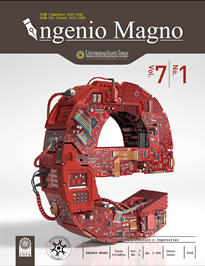Fuzzy control for a half bridge bidirectional dcdc converter
Main Article Content
Abstract
Downloads
Article Details
DECLARATION OF ORGINIALITY OF SUBMITTED ARTICLE
With this document, I/We certify that the article submitted for possible publication in the institutional journal INGENIO MAGNO of the Research Center Alberto Magno CIIAM of the University Santo Tomás, Tunja campus, is entirely of my(our) own writing, and is a product of my(our) direct intellectual contribution to knowledge.
All data and references to completed publications are duly identified with their respective bibliographical entries and in the citations thus highlighted. If any adjustment or correction is needed, I(we) will contact the journal authorities in advance.
Due to that stated above, I(we) declare that the entirety of the submitted material is in accordance with applicable laws regarding intellectual and industrial property, and therefore, I(we) hold myself(ourselves) responsible for any complaint related to it.
If the submitted article is published, I(we) declare that I(we) fully relinquish publishing rights of the article to the University Santo Tomás, Tunja campus. As remuneration for this relinquishment of rights, I(we) declare my(our) agreement to receive two (2) copies of the edition of the journal in which my(our) article appears.
References
Castellanos M., P. (2003). Programación del control para un convertidor CD/CD en un DSP (Reporte interno).
Govindaraj, T. y Rasila, R. (2010). Development of fuzzy logic controller for dc–dc buck converters. International Journal of Engineering Techsci, 2(2), 192-198.
Kessal, A., Rahmani, L., Mostefai, M. y Gaubert, J. (2012). Power factor correction based on fuzzy logic controller with fixed switching frequency. Electronics & Electrical Engineering, 118.
Khaburi, D. A. y Rostami, H. (2011). Controlling the both dc boost and ac output voltages of a z-source inverter using neural network controller with minimization of voltage stress across devices. Iranian Journal of Electrical & Electronic Engineer-ing, 7(1).
Mohan, N., Tore, U. y Robbins W. P. (2009). Electrónica de potencia: convertidores, aplicaciones y diseño (3.ª ed.). Ciudad de México: McGraw-Hill.
Muruganandam, M., Thangaraju, I. y Madheswaran, M. (2014). Simulation and implementation of an embedded hybrid fuzzy trained artificial neural network controller for different DC Motor. Rasipuram: Muthayammal Engineering College.
National Instruments (2014). NI LabVIEW for CompactRIO: Developer’s Guide. Recuperado de https:// www.ni.com/compactriodevguide/
Rashid, M. H. (2010). Power electronics handbook: devices, circuits and applications (3.a ed.). Burlington: Elsevier.
Rameshkumar, A. y Arumugam, S. (2009). Design and simulation of fuzzy controlled quasi resonant buck converter. ARPN Journal of Engineering and Applied Sciences, 4(5), 91-100
So, W. C., Tse, C. K. y Lee, Y. S. (1996). Development of a fuzzy logic controller for DC/DC converters: design, computer simulation, and experimental evaluation. IEEE Transactions on Power Electronics, 11(1), 24-32.

